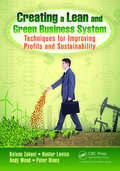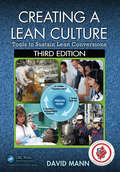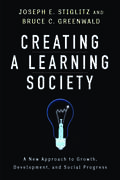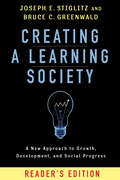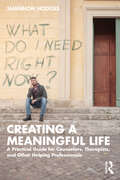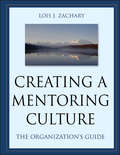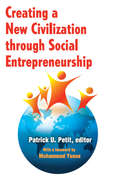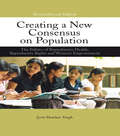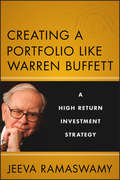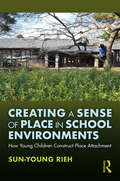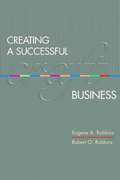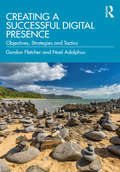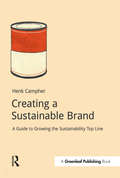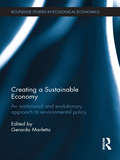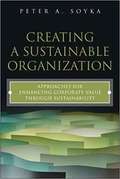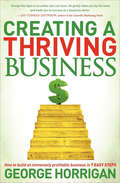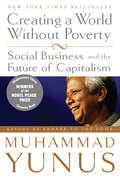- Table View
- List View
Creating a Lean and Green Business System: Techniques for Improving Profits and Sustainability
by Keivan Zokaei Hunter Lovins Andy Wood Peter HinesThings that are good for the planet are also good for business. Numerous studies from the likes of the Economist Intelligence Unit, Harvard, MIT Sloan, and others indicate that organizations that commit to goals of zero waste, zero harmful emissions, and zero use of nonrenewable resources clearly outperform their competition.Like lean thinking, gre
Creating a Lean Culture: Tools to Sustain Lean Conversions, Third Edition
by David MannWinner of a Shingo Research and Professional Publication AwardThe new edition of this Shingo Prize-winning bestseller provides critical insights and approaches to make any Lean transformation an ongoing success. It shows you how to implement a sustainable, successful transformation by developing a culture that has your stakeholders throughout the o
Creating a Learning Society
by Philippe Aghion Kenneth J. Arrow Joseph E. Stiglitz Bruce C. Greenwald Robert M. SolowIt has long been recognized that most standard of living increases are associated with advances in technology, not the accumulation of capital. Yet it has also become clear that what truly separates developed from less developed countries is not just a gap in resources or output but a gap in knowledge. In fact, the pace at which developing countries grow is largely determined by the pace at which they close that gap.Therefore, how countries learn and become more productive is key to understanding how they grow and develop, especially over the long term. In Creating a Learning Society, Joseph E. Stiglitz and Bruce C. Greenwald spell out the implications of this insight for both economic theory and policy. Taking as a starting point Kenneth J. Arrow's 1962 paper "Learning by Doing," they explain why the production of knowledge differs from that of other goods and why market economies alone are typically not efficient in the production and transmission of knowledge. Closing knowledge gaps, or helping laggards learn, is central to growth and development.Combining technical economic analysis with accessible prose, Stiglitz and Greenwald provide new models of "endogenous growth," upending the received thinking about global policy and trade regimes. They show how well-designed government trade and industrial policies can help create a learning society; explain how poorly designed intellectual property regimes can retard learning; demonstrate how virtually every government policy has effects, both positive and negative, on learning; and they argue that policymakers need to be cognizant of these effects. They provocatively show why many standard policy prescriptions, especially associated with "neoliberal" doctrines focusing on static resource allocations, impede learning and explain why free trade may lead to stagnation, while broad based industrial protection and exchange rate interventions may bring benefits, not just to the industrial sector, but to the entire economy.The volume concludes with brief commentaries from Philippe Aghion and Michael Woodford, as well as from Nobel Laureates Kenneth Arrow and Robert Solow.
Creating a Learning Society: A New Approach to Growth, Development, and Social Progress (Kenneth J. Arrow Lecture Series)
by Joseph E. Stiglitz Bruce GreenwaldIt has long been recognized that an improved standard of living results from advances in technology, not from the accumulation of capital. It has also become clear that what truly separates developed from less-developed countries is not just a gap in resources or output but a gap in knowledge. In fact, the pace at which developing countries grow is largely a function of the pace at which they close that gap. Thus, to understand how countries grow and develop, it is essential to know how they learn and become more productive and what government can do to promote learning. In Creating a Learning Society, Joseph E. Stiglitz and Bruce C. Greenwald cast light on the significance of this insight for economic theory and policy. Taking as a starting point Kenneth J. Arrow's 1962 paper "Learning by Doing," they explain why the production of knowledge differs from that of other goods and why market economies alone typically do not produce and transmit knowledge efficiently. Closing knowledge gaps and helping laggards learn are central to growth and development. But creating a learning society is equally crucial if we are to sustain improved living standards in advanced countries. Combining accessible prose with technical economic analysis, Stiglitz and Greenwald provide new models of "endogenous growth," up-ending thowhe thinking about both domestic and global policy and trade regimes. They show well-designed government trade and industrial policies can help create a learning society, and how poorly designed intellectual property regimes can retard learning. They also explain how virtually every government policy has effects, both positive and negative, on learning, a fact that policymakers must recognize. They demonstrate why many standard policy prescriptions, especially those associated with "neoliberal" doctrines focusing on static resource allocations, have impeded learning. Among the provocative implications are that free trade may lead to stagnation whereas broad-based industrial protection and exchange rate interventions may bring benefits—not just to the industrial sector, but to the entire economy. The volume concludes with brief commentaries from Philippe Aghion and Michael Woodford, as well as from Nobel Laureates Kenneth J. Arrow and Robert M. Solow.
Creating a Learning Society: A New Approach to Growth, Development, and Social Progress, Reader's Edition (Kenneth J. Arrow Lecture Series)
by Joseph E. Stiglitz Bruce GreenwaldSince its publication Creating a Learning Society has served as an effective tool for those who advocate government policies to advance science and technology. It shows persuasively how enormous increases in our standard of living have been the result of learning how to learn, and it explains how advanced and developing countries alike can model a new learning economy on this example. Creating a Learning Society: Reader's Edition uses accessible language to focus on the work's central message and policy prescriptions. As the book makes clear, creating a learning society requires good governmental policy in trade, industry, intellectual property, and other important areas. The text's central thesis—that every policy affects learning—is critical for governments unaware of the innovative ways they can propel their economies forward.
Creating a Learning Society: A New Approach to Growth, Development, and Social Progress (Kenneth J. Arrow Lecture Series)
by Joseph E. Stiglitz Bruce C. Greenwald&“A superb new understanding of the dynamic economy as a learning society, one that goes well beyond the usual treatment of education, training, and R&D.&”—Robert Kuttner, author of The Stakes: 2020 and the Survival of American Democracy Since its publication Creating a Learning Society has served as an effective tool for those who advocate government policies to advance science and technology. It shows persuasively how enormous increases in our standard of living have been the result of learning how to learn, and it explains how advanced and developing countries alike can model a new learning economy on this example. Creating a Learning Society: Reader&’s Edition uses accessible language to focus on the work&’s central message and policy prescriptions. As the book makes clear, creating a learning society requires good governmental policy in trade, industry, intellectual property, and other important areas. The text&’s central thesis—that every policy affects learning—is critical for governments unaware of the innovative ways they can propel their economies forward. &“Profound and dazzling. In their new book, Joseph E. Stiglitz and Bruce C. Greenwald study the human wish to learn and our ability to learn and so uncover the processes that relate the institutions we devise and the accompanying processes that drive the production, dissemination, and use of knowledge . . . This is social science at its best.&”—Partha Dasgupta, University of Cambridge &“An impressive tour de force, from the theory of the firm all the way to long-term development, guided by the focus on knowledge and learning . . . This is an ambitious book with far-reaching policy implications.&”—Giovanni Dosi, director, Institute of Economics, Scuola Superiore Sant&’Anna &“[A] sweeping work of macroeconomic theory.&”—Harvard Business Review
Creating a Life Together
by Patch Adams Diana Leafe ChristianCreating a Life Together is the only resource available that provides step-by-step practical information distilled from numerous firsthand sources on how to establish an intentional community. It deals in depth with structural, interpersonal and leadership issues, decision-making methods, vision statements, and the development of a legal structure, as well as profiling well-established model communities. This exhaustive guide includes excellent sample documents among its wealth of resources.Diana Leafe Christian is the editor of Communities magazine and has contributed to Body & Soul, Yoga Journal, and Shaman's Drum, among others. She is a popular public speaker and workshop leader on forming intentional communities, and has been interviewed about the subject on NPR. She is a member of an intentional community in North Carolina.
Creating a Marketing Plan: An Overview
by Richard LueckeEffective marketing cannot begin without an effective marketing plan. The marketing plan serves to define the opportunity, the strategy, the budget, and the expected results of product sales. In this chapter, the individual elements that comprise the plan are introduced, as are details on how to implement adequate research in considering each decision therein.
Creating a Meaningful Life: A Practical Guide for Counselors, Therapists, and Other Helping Professionals
by Shannon HodgesCreating a Meaningful Life builds on the tenets of mindfulness-based cognitive therapy (MBCT) to answer some of life’s basic questions, such as "How do I create a meaningful, purposeful life?" and "Is the life I am living one that brings me fulfillment, purpose, and a sense of inner peace?" Using a variety of techniques, including journaling, grounding exercises, cognitive self-talk restructuring, and more, chapters invite counseling professionals and students to explore their inner landscape, better understand themselves and find communion with others.
Creating a Mentoring Culture
by Lois J. ZacharyIn order to succeed in today's competitive environment, corporate and nonprofit institutions must create a workplace climate that encourages employees to continue to learn and grow. From the author of the best-selling The Mentor's Guide comes the next-step mentoring resource to ensure personnel at all levels of an organization will teach and learn from each other. Written for anyone who wants to embed mentoring within their organization, Creating a Mentoring Culture is filled with step-by-step guidance, practical advice, engaging stories, and includes a wealth of reproducible forms and tools.
Creating a New Civilization Through Social Entrepreneurship
by Patrick PetitHumanity is confronted with the gravest financial crisis and economic recession since the Great Depression. Political leaders, national ministries of finance, and central banks around the world are trying to prop up their countries' sinking economies and arrest a downward economic spiral by innovative financial rescue and bank bailout plans, as well as economic stimulus and recovery packages. These measures are being taken to reestablish trust in the economy and to trigger an economic revival. Despite these efforts, stagnation seems imminent, as uncertainty leads businesses and consumers to place spending and investing decisions on hold.Social entrepreneurs are essential to the restoration of a sustainable planet and the improvement of lives of billions of people, especially of those living in extreme poverty. Therefore, social entrepreneurs deserve further recognition and support by the international community - by governments, multinational companies, and philanthropic organizations. Creating a New Civilization through Social Entrepreneurship highlights the global movement of social entrepreneurship and some of the leading organizations and individuals that are advancing this citizen sector movement. The volume presents examples of innovative people that are tackling major social problems and triggering systemic change throughout the world today.
Creating a New Consensus on Population: The Politics of Reproductive Health, Reproductive Rights, and Women's Empowerment
by Jyoti Shankar SinghPopulation growth, reproductive health and reproductive rights are amongst the most pressing issues facing governments and the international community. Since the world's governments agreed for the first time on far-reaching and enlightened population policies at the 1994 International Conference on Population and Development (ICPD) in Cairo, a good deal of progress has been made on these issues, but major challenges remain. This fully updated edition of Creating a New Consensus on Population charts international progress on efforts to address population and development, reproductive health, reproductive rights, religion, contraception and the empowerment of women. Historical coverage includes the lead up process to the ICPD, the conference itself and the global consensus and the ICPD Programme of Action that resulted. The book then turns to how population issues have developed over the past decade and a half including follow-up and implementation at the international level by the United Nations Population Fund (UNFPA) and other UN agencies and organizations. Key international events are covered including the 1999 ICPD+5, Millennium Summit 2000, ICPD+10 and the 2005 MDG+5 as well as relevant regional events. The book also examines the reorientation of policies and programmes and implementation at national levels across the world. Crucially, it looks at emerging issues and partnerships including the increasing role of NGOs, women's groups, youth groups, foundations, public-private partnerships and other non-state stakeholders. Written by Jyoti Shankar Singh, former ICPD Executive Coordinator, this is the definitive account of how the international community has engaged with population issues and policies and it offers insight into both the ongoing challenges as well as how an international consensus can be forged on crucial global issues. It is essential reading for all those involved in population, health and development issues and policies world-wide.
Creating a New Management University: Tracking the Strategy of Singapore Management University (SMU) in Singapore (1997–2019/20)
by Howard Thomas Alex Wilson Michelle P. LeeThis book provides an in-depth exploration of one of the most significant success stories of the development of an entrepreneurial university in recent times as well as its role within society and the economy. Written by leading business school Dean and scholar, Howard Thomas, and Alex Wilson and Michelle Lee, the book tracks the genesis of the idea of a third local university in Singapore to its fruition as Singapore Management University (SMU). It provides important insight and lessons for senior university and business school leaders, as well as regional and national governments. The increasing emphasis on the importance of innovative, entrepreneurial universities for social and economic growth has prompted this review of the strategy and impact of SMU. The book addresses the strategic evolution of SMU itself, from its origins as a single business school, into a multi-school, social science-focused school of management. It examines whether it has fulfilled its promise as an entrepreneurial university and a change agent in the context of Singapore’s strong economic growth and educational strategy. More broadly, it explores how investment in education, and entrepreneurial universities such as SMU, can facilitate and enhance economic growth. University leadership teams, policy analysts, faculty and students of entrepreneurship education, education management and policy in general, and business education in particular, will find this book an invaluable insight into building a genuinely entrepreneurial university.
Creating a Portfolio like Warren Buffett
by Jeeva RamaswamyThe practical guide to investing the Warren Buffett wayCreating a Portfolio like Warren Buffett: A High Return Investment Strategy highlights actual trades author Jeeva Ramaswamy has successfully executed using principles established by investment guru Warren Buffet. Clearly explaining how Buffett's principles can be used to make specific investments the book, unlike other investment guides, also clearly explains how to apply Buffett's exit strategies as they pertain to holding or selling positions.Giving readers a complete overview of Buffett's methodologies and how to apply them, the book is a step-by-step stock research checklist and comprehensive guide to investing and managing a successful stock portfolio. It includes detailed instructions to:Determine where to search for stock prospectsThoroughly research stocks using a stock research checklistConfidently make buy and sell decisionsExpertly manage your portfolioPacked with specific stock examples, real-life calculations, and expert tips, Creating a Portfolio like Warren Buffett is your guide to harnessing the market savvy of an investing legend.
Creating a Roadmap Towards Circularity in the Built Environment (Springer Tracts in Civil Engineering)
by Luís Bragança Meri Cvetkovska Rand Askar Viorel UngureanuThis open access book summarizes the research being pursued as part of the COST Action CA21103 titled "Implementation of Circular Economy in the Built Environment" (Circular B), which aims to define the methodology to develop a common circularity framework for inclusive application and assessment in new and existing buildings to support decision-making for all value chain stakeholders and appraise the implementation level of the European Circular Economy Action Plan (CEAP). The Action is increasingly gaining interest worldwide, bringing multidisciplinary young and experienced researchers together to share the latest studies and develop new knowledge. Consisting of 17 chapters corresponding to the conference themes, the book analyses and discusses topics such as Circular Economy (CE) best practices, design strategies for circular buildings, circular materials and products, adaptive reuse of existing buildings, recovery and reuse of salvaged materials and products, case studies of current applications and trends, barriers against CE implementation in buildings, efficient waste and circular resource management, circular lifecycle management and decision making, stakeholders relationships, CE supporting policies and barriers, circular business models, criteria, KPIs and assessment models for circular buildings, CE criteria in sustainability frameworks, digitalization and BIM for enhanced circularity of buildings and building materials, and standardization of CE definitions in buildings.
Creating a Sense of Place in School Environments: How Young Children Construct Place Attachment
by Sun-Young RiehCreating a Sense of Place in School Environments guides its readers to the characteristics that tend to generate a sense of place through children’s vivid descriptions of their school and provides a body of critical information that can be employed to design a better school environment that can imprint cherished childhood memories. The childhood school environment calls for special attention regarding the sense of place it creates. The sense of place in childhood both affects children's current quality of life and frames their lasting world view. It is well known that children's cognitive development is closely related to their place attachment to their surroundings, and that children’s adaptation to a given environment depends on how such place attachment can be created. Therefore, it is natural that people’s identity in the world is the accumulation of their experience of place while in childhood. Cross-checking between the imprint of adults' memories of places in school and children’s current "lived experience" of their favorite school place confirmed that certain spatial configurations, which the author herein refers to as "place generators" can generate positive attributes of physical settings that construct a sense of place and last as lifelong memories. It is an ideal read for academics, students, and professionals.
Creating a Strategic Energy Reduction Plan
by CEM OffermannThis book outlines a simple and easy-to-follow process for auditing building operation to identify and reduce energy consumption. It explains the operational and cost-based opportunities, assessing the current conditions, analyzing the opportunities, and reporting the findings and documenting the plan. The book discusses the different building components and systems and how they affect energy efficiency and describes the operational energy efficiencies that can be gained by implementing no cost changes or alternate maintenance activities already funded. Capital improvement opportunities, and evaluating Return on Investment and life cycle replacement of equipment are also covered.
Creating a Strategic Energy Reduction Plan
by Scott OffermannThis book provides a simple, easily followed process for auditing building operations to identify and reduce energy consumption that leads to measurable carbon reduction. The crucial steps of this process involve assessing the facility’s current conditions, understanding, and analyzing the operational and cost-based opportunities that increase carbon output. Taking this information to report the findings and then document a multiyear energy and carbon reduction plan. The book discusses the full scope of building components and systems, including how each system affects energy efficiency. It describes the operational energy efficiencies that are gained by implementing no-cost changes or alternative maintenance activities already funded. The book includes the process for identifying capital improvement opportunities, along with evaluating return on investment and life cycle replacement options for equipment. The four-step process described in this book will serve as a valuable tool for every building operator seeking to improve energy performance and reduce carbon output.
Creating a Successful Craft Business
by Rogene A. Robbins Robert RobbinsFrom writing a business plan and financing an idea to choosing the most cost-efficient production method and best-suited sales approach, Creating a Successful Crafts Business provides a sound blueprint for turning a beloved hobby into a lucrative career. Written by two experienced craftspeople who have been through the trials, tribulations, and triumphs of running a crafts business, readers will learn, step by step, how to negotiate with bankers, choose the ideal retail location, promote the business on-line, expand into lucrative new markets, and much more. Filled with the infectious spirit of people who have "been there," this down-to-earth book will bring fledging craft businesses to new levels of profits and success.
Creating a Successful Digital Presence: Objectives, Strategies and Tactics
by Gordon Fletcher Noel AdolphusIncreasingly graduates, and anyone who is entering employment, need an individual digital presence to stand out and showcase themselves to secure their first professional role. This book takes an employability approach to encourage those currently studying, or about to enter the world of work, to develop a set of skills that enables them to recognise and deliver an effective digital presence, firstly for themselves and then for the organisations who would employ them. It does not assume any prior technical knowledge and emphasises the value and benefits of creating a presence to actively participate in the digital economy. By structuring the chapters incrementally, the reader is guided through the development of their own presence while also being given the concepts and tools that will enable them in the future to scale this activity to suit the needs of a startup, an SME or a social business. By using well-established business principles to design a strategy, the reader is guided through the creation of a personal Theory of Change that will enable them to turn an abstract goal into an individual digital presence through a defined series of stages and intermediate change objectives. The book then proposes a series of tactics to draw out concrete actions. A range of examples and case studies from around the world feature in each chapter to showcase the range of different types of digital presence that can be created. By using a strategic and systematic process, this book draws together academic thinking with tangible and highly practical outcomes. It is essential reading for advanced undergraduate and postgraduate students studying any discipline related to the digital world, particularly digital marketing and digital business, entrepreneurship and strategy, as well as those taking employability and personal professional development programmes.
Creating a Sustainable Brand: A Guide to Growing the Sustainability Top Line (Doshorts Ser.)
by Henk CampherSustainable brands may have started as "doing less harm" and shaving costs off the bottom line. But brands today, supported by over a decade of phenomenal changes in sustainability, are looking for the holy grail of sustainable business – a fusion of products and branding that can actually drive sustainability and grow the business top line.Consumers have already joined the party. Just look at TOMS, Patagonia, Method, Seventh Generation, Dove and many more. What is missing isn’t the consumer but a better understanding of what fully-rounded consumers really want in their quest for a healthy, fulfilling life.This guide by sustainable brand expert Henk Campher is the model for creating a sustainable brand that people can trust, buy and above all, advocate for. Campher cuts through the myths and noise to offer an experienced expert's 101 for creating an irresistible brand, clearly setting out: what makes a product or service sustainable; the basic elements of sustainable branding strategy and a deep understanding of how consumers connect with a brand; an original model for assessing the sustainability of your brand, and; a host of examples of sustainable brands, drawing on the author's firsthand experience as part of the team at Edelman and Oxfam and founder of the Nelson Mandela initiated Proudly South African campaign.
Creating a Sustainable Economy: An Institutional and Evolutionary Approach to Environmental Policy (Routledge Studies In Ecological Economics Ser. #21)
by Gerardo MarlettoThis book is designed for those scholars, students, policy-makers – or just curious readers– who are looking for heterodox thinking on the issue of environmental economics and policy. Contributions to this book draw on multiple streams of institutional and evolutionary economics and help build an approach to environmental policy that radically diverges from mainstream prescriptions. No 'silver bullet' solutions emerge from the analyses. Even market-based tools – such as green taxes or tradable pollution permits – are bound to fail if they are not incorporated into an integrated, multi-dimensional and multi-actor policy for structural change.
Creating a Sustainable Organization: Approaches for Enhancing Corporate Value Through Sustainability
by Peter A. SoykaOrganizations that prioritize environmental, health, and safety (EHS) issues are well placed to attract better customers, better talent, and today's growing number of socially responsible investors. But, to gain these benefits, companies must choose the right sustainability strategies, and then manage and measure them well. Now, leading business sustainability consultant Peter Soyka offers a complete and actionable guide to driving greater value through sustainability. In Creating a Sustainable Organization, Soyka bridges the disparate worlds of the EHS/sustainability professional and the investor/analyst. Readers will learn what the evidence says about linkages between sustainability and value… how to manage key stakeholder relationships influencing corporate response to EHS and social equity issues… how to effectively manage sustainability throughout the business… how to evaluate sustainability posture and performance from the standpoint of external investors and internal management… how to maximize the influence of organizational actors focused on sustainability, and much more. This book will be invaluable for all environmental, health, and safety decision-makers and professionals concerned with improving sustainability and value; for executives and strategists seeking long-term competitive advantage; for stock analysts evaluating potential investments; and for researchers and MBA candidates currently studying the techniques and potential of corporate sustainability.
Creating a Thriving Business: How to Build an Immensely Profitable Business in 7 Easy Steps
by George HorriganA practical plan for entrepreneurs that &“takes you by the hand and leads you to success as a business owner&” (Jay Conrad Levinson, national-bestselling author of Guerrilla Marketing). Most business owners and leaders have expectations for today, hopes for tomorrow, and dreams for down the road. But how do they get from here to there? Using a systematic, structured methodology build upon George Horrigan&’s experience with over 1,200 businesses over the past seventeen years, Creating a Thriving Business shows business owners, leaders, and managers how to solve real-world problems and get the kind of results they want. With a proven, practical, and comprehensive methodology that is simple to understand, straightforward, easy to implement, and extremely effective, readers can achieve their goals faster, thereby turning today&’s problems into tomorrow&’s promise. Creating a Thriving Business shows, step by step, how to create a successful business by reducing the guesswork, trial and error, and uncertainty associated with trying to beat the competition and increase profitability.
Creating a World Without Poverty: Social Business and the Future of Capitalism
by Muhammad YunusIn this newly updated national bestseller, Nobel Peace Prize?winner Muhammad Yunus outlines his vision of a new business model that combines the power of free markets with the quest for a more humane world.
